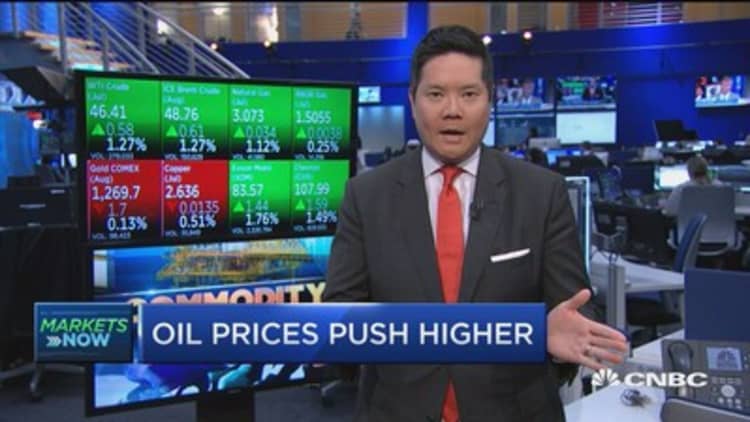
Oil prices pared gains around midday on Monday after earlier rising nearly 2 percent on signs of inventory declines in the United States and news that Saudi Arabia will limit exports in July.
Saudi Arabia, the world's top oil exporter, will cut crude allocations to Asia in July to a total of about 300,000 barrels per day (bpd), deeper than in June, sources told Reuters. One source said volumes to the United States would be cut by about 35 percent in July.
Data from market intelligence firm Genscape estimating a draw of more than 1.8 million barrels at the Cushing, Oklahoma delivery point for U.S. crude futures last week added to the bullish sentiment, said traders who saw the data.
U.S. West Texas Intermediate (WTI) crude futures ended Monday's session 25 cents higher to $46.08 per barrel , after earlier rising as high as $46.71. Brent crude futures was up 13 cents to $48.28 per barrel by 2:39 p.m. ET (1839 GMT), off a session high of $49.15.

Prices plunged about 5 percent last week after data from the U.S. Department of Energy showed a surprise increase in stockpiles.
"We think the market's negative reaction to a one-week counter-seasonal crude inventory build of 3.3 million barrels was excessive, at least relative to its lack of positive reaction to draws amounting to 10.9 million barrels in the previous two weeks of data," Standard Chartered analysts said in a note.
"We do not expect a repeat of the inventory increase this week; rather we see a further large inventory draw."
Some traders and analysts had warned the rise looked technical in nature, after WTI rallied and encouraged a similar move in the Brent market. But they said the move might prove fleeting.
"When you start to approach $45 a barrel in WTI, you're in an area where you do find some price support and I think there has been some evidence last week of investment flows coming back into crude oil," Petromatrix strategist Olivier Jakob said.
"You have to be careful not to be too optimistic for now," he said. "Physical differentials are still under pressure and the time structure is still under pressure in Brent. It's a bit premature to call for much higher oil prices."

Traders said the price rises came as data showed speculative traders had increased their investment in crude futures by taking on large volumes of long positions.
"Oil bulls have reset for a technical bounce," said Stephen Schork, author of the Schork Report.
While financial traders have confidence in rising prices, the physical market remains under pressure, especially due to a rise in U.S. drilling.
U.S. drillers added eight oil rigs in the week to June 9, bringing the total count to 741, the most since April 2015, energy services firm Baker Hughes Inc said on Friday.
U.S. output has risen by more than 10 percent since mid-2016, undermining OPEC-led pledges to cut almost 1.8 million bpd of production until the first quarter of 2018. Brent and WTI futures have lost about 10 percent in value since May 25, when the Organization of the Petroleum Exporting Countries and 11 of its partners extended supply restrictions.

The oil price hit one-month lows last week, as evidence of rising output beyond the United States, in the likes of Libya and Nigeria, added to investor bearishness over supply.
"With the typically tighter second half of the year fast approaching, rumours of oil prices having found their bottom are doing the rounds," PVM Oil Associates analyst Stephen Brennock said in a note.
"Yet such claims are premature as lingering doubts that prolonged OPEC curbs will drain the oil glut along with the simultaneous uptick in U.S., Libyan and Nigerian output make for a bearish cocktail."

